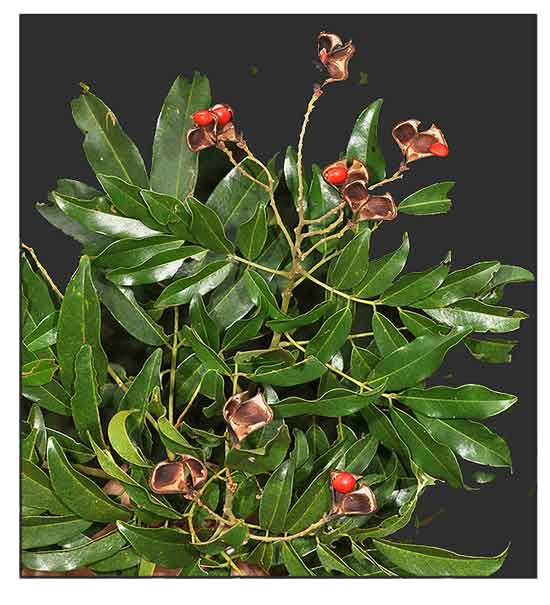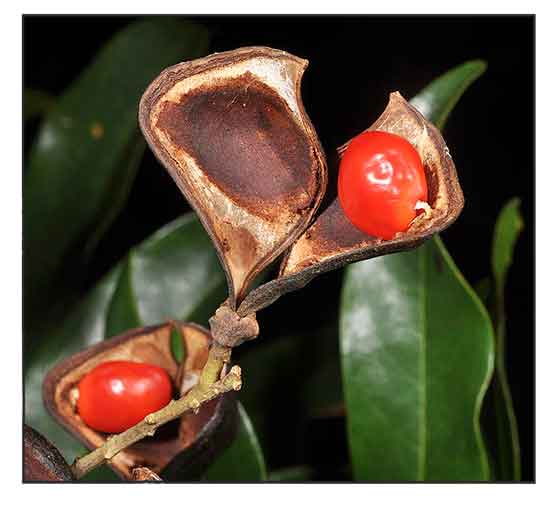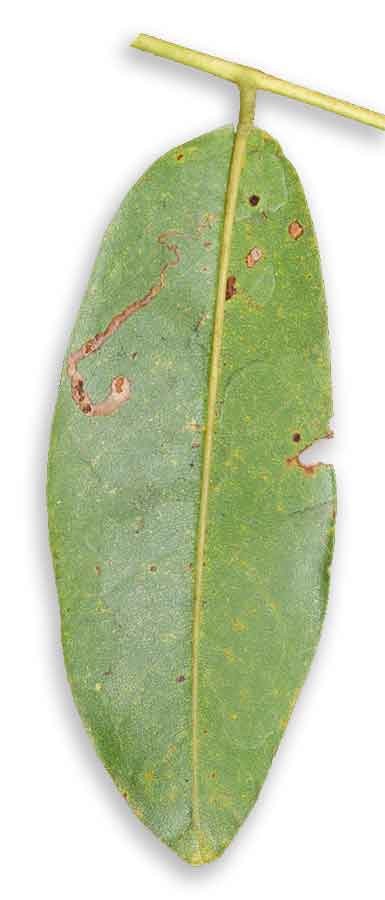 Gen info Gen info
- Ormosia is a genus of legumes in the family Fabacea, comprising 131 living species, mostly trees or large shrubs. Plants in the genus as commonly known as horse-eye beans or simply ormosias.
Botany
• Ormosia calavensis is a small sub-canopy tree (up to 20 m high); Bole cylindrical (up to 60 cm diam.); straight (bole up to 8 m long); buttresses buttresses present; spines spines absent; aerial roots aerial roots absent; stilt roots stilt roots absent; Bark gray or dark brown, rough, fissured or pustular, lenticels elongated vertically; Subrhytidome (under-bark) pale yellow; less than 25 mm thick; bark blaze with two layers; faintly to non-aromatic; outer blaze pale yellow, with stripes (brown); inner blaze white (cream-colored), with stripes (brown); bark exudate (sap) absent; terminal buds not enclosed by leaves. Indumentum: Complex hairs absent; stinging hairs absent; mature twig indumentum (hairs) absent. Leaves: Leaves spaced along branches, spiral (leaves occurring singly at a node and arranged spirally up the branchlet), compound (a leaf made up from two or more leaflets); petiole present, not winged, attached to base of leaf blade, not swollen; leaves pinnate (unbranched with more than three leaflets); petiolule slightly swollen; rachis present, absent, absent; leaves with a terminal leaflet (the number of leaflets odd - imparipinnate), broadest at or near middle or equally broad throughout much of length, 2.5-15.0 cm, 1.8-55.0 (-70.0) cm, leaflets opposite, symmetric, terminal developing leaflet buds absent; venation pinnate, secondary veins open, prominent, intramarginal veins absent; leaves lower surface green, upper surface dull dark green, indumentum (hairs) absent or present, indumentum (hairs) dense to sparse; absent; domatia absent; stipules present, free, laterally placed, not encircling the twig, scale-like, not fringed, small, not persistent. Flowers: Inflorescence terminal and axillary, flowers on a branched axis, cones absent; flowers bisexual, stalked, flowers with one plane of symmetry, 8.0-12.0 mm long, diameter large (more than10 mm diam.); perianth present, with distinct sepals and petals whorls, inner perianth white or at base mauve; 5, free; stamens 10, present, at base joined, free of the perianth; ovary superior, carpels joined (when more than one), locules 1; styles solitary, 1. Fruits: Infrutescence arranged on branched axis, fruit 20.0-40.0 mm long, brown to black, not spiny, non-fleshy, simple, dehiscent, legume; seeds 1 (-2), about 10 mm long (9-13 mm long), not winged, broad (as wide as long), seed 1-10 mm diam. (flattened, 8-11 mm wide). (3)
 Distribution Distribution
- Native to the Philippines.
- In dipterocarp forests, at low and medium altitudes.
- Also native to Borneo, Caroline Is., Jawa, Maluku, New Guinea, Sulawesi. (1)
Constituents
- Study of bark extract of O. calavensis yielded alkaloids, steroids, flavonoids. saponins, and tannins. (see study below) (4)
- Study of leaf extract for secondary metabolites yielded alkaloids, flavonoids, leucoanthocyanin, saponins, tannin, terpenoids, with absence of triterpene and anthraquinone. (5)
Properties
- Studies have suggested anticancer, anti-angiogenic, anti-inflammatory properties.
 Parts used Parts used
Bark, leaves, roots.
Uses
Edibility
- No info found on fruit edibility.
Folkloric
- The Manobo tribe of Brgy. Anticala, Butuan City, Philippines use decoction of bark and leaves to treat fever, diarrhea, flu, and relapse. Paste of roots use on wounds. (4)
- Decoction of bruised leaves used for treatment of stomach aches.
Others
- Crafts: Brightly colored seeds used for making necklaces.
- Wood: Use for light construction, furniture making, cabinetry, and agricultural implements.
Studies
• Anticancer / Anti-Angiogenesis / Bark: Study evaluated the barks of Ormosia calavensis and S. agsaboensis for phytochemical content, anticancer, and anti-angiogenesis potential. MTT assay of bark extract of O. calavensis showed mild toxicity against colon cancer cell line HCT116 (76.97% viability). The bark extract also showed dose-dependent antiangiogenic activity in the CAM (chorioallantoic membrane) of duck embryos (p<0.05). (4)
• Anti-Inflammatory / Leaves: Study of O. calavensis leaf extract showed anti-inflammatory activity using carrageenan induced paw edema in albino mice. Indomethacin was used as postive control. (see constituents above) (5)
Availability
Wild-crafted. |

![]()




 Distribution
Distribution
